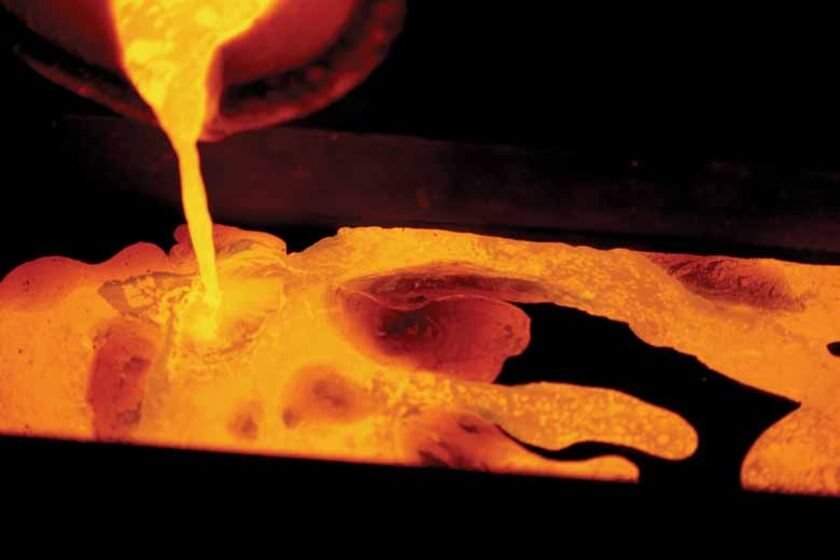Smelter is a machine for taking metal out of rock by smelting it (= heating it to a very high temperature)
A smelter is a smelting machine for removing metal from rock by heating it to very high temperatures. This form of extractive metallurgy is suitable for extracting metals such as tin, lead, copper, iron, aluminum and zinc.
Extraction of metals by calcination (heating) or smelting
Metal extraction by calcination is a separation technique for analytical preparations aimed at extracting metal analytes from minerals and their organic matrices.
It consists in subjecting the sample to very high temperatures to reduce the organic matter contained in the solid matrix to ash. Thus free from organic matter and water, the ash analysis will easily obtain information about the various analytes present by the appropriate method. Basically, this method is considered as a benchmark to identify the relative presence of trace elements.
Another technique commonly used to extract metal analytes is metal extraction by acid digestion.

Electric phosphate smelting furnace in a TVA chemical plant (1942). Alfred T. Palmer, Public domain, via Wikimedia Commons
Matrix or mold treatment before calcination
Prior to calcination, samples can be treated with certain additives to improve the procedure to eliminate potential losses and/or speed up the calcination procedure. For example, salts such as magnesium nitrate, sodium carbonate and magnesium oxide can be added to reduce the interaction between the analyte and the vessel wall which acts as a sorbent. Especially when the crucible is made of silica, as it retains the metal contained in the calcined matrix. The crucible is a refractory material that can withstand high temperatures, which are needed to be able to calcinate the sample. The way to degrade it is to use hydrofluoric acid, which will facilitate the dissolution of the analyte in solution.
This always increases the risk of contamination and leads to higher detection limits, because usually lower detection limits are better than high detection limits because they are less selective.
Advantages
This technique also has advantages. It is possible to reduce a large amount of organic matrix. It requires a little attention, a little reagent and a little white. There is complete destruction of the organic matrix which may be required for certain detection techniques such as inductively coupled plasma atomic emission spectrometry (ICP-AES or Inductively coupled plasma atomic emission spectroscopy).
The advantage of dry ash is that the resulting ash can be dissolved in a small amount of a diluent which may be acidic, allowing for better detection. This applies to various samples.
What is a foundry?
Foundries are facilities that produce metal parts and provide services associated with those parts. Foundries are responsible for our current standard of living and industrial development, but most of us know next to nothing about them. So what is a Foundry?
Foundry definition
In simplified terms, a foundry is a factory where parts are produced by melting metal, pouring the liquid metal into molds, and then allowing them to solidify. Even if you’ve never been to a foundry, or don’t even know what it looks like, you’re surrounded by the pieces of metal they produce. There’s a good chance that while reading this you’re within 10 feet of one.
Foundries do not only produce metal products for engines, railways or pipe parts. They also shape machine parts that are needed to make many of the essential consumer products we depend on. 90 percent of all manufactured items depend on metal parts.
Open hearth furnace workers in Ukraine taking a steel sample, c. 2012. Viktor Mácha, CC BY-SA 4.0, via Wikimedia Commons
The Casting Process
In order to understand a foundry, you must understand the casting process. The general steps involved in casting are shaping, molding, melting, pouring, ejecting, cleaning, trimming and inspection.
The final shape matches the mold it is poured into, so molds are carefully formed with a template — a wooden or metal replica of the object to be formed. The most common mold material is silica sand, but they can be made from a number of different materials depending on the metal of the part and the method used.
A melting furnace is “filled” with metal and heated above the metal’s melting point. Once the metal has reached a specific casting temperature it is poured from the furnace via a spout into a refractory steel ladle. Any slag or impurities are skimmed off the surface of the molten metal. The ladle is then tipped with the molten metal towards the mold cavity.
Filling is one of the most dangerous foundry operations. Mistakes can be deadly.
The mold cools and the metal solidifies, then the part is ejected from the mold and cleaned. The cleaned part is finished by trimming, a process that removes excess metal from the part to match the specified dimensions of the finished product. Depending on the specifications of the casting, deburring can be quick and simple, or an extremely detailed job. The finished parts are then inspected by the foundry before being shipped.
Foundries don’t just produce raw parts. They host a number of operations that often include part design, tooling, prototyping, machining, assembly and other aftermarket services.
Flow of materials circulating inside a blast furnace (metallurgical heater or like a big oven). Borvan53, CC BY-SA 3.0, via Wikimedia Commons
Foundry Equipment
Modern foundries are highly mechanized. They contain all the machinery and equipment used in patterning, core making, casting and molding. This assortment includes large melting furnaces, ladles, forklifts, cranes, conveyor belts and transfer containers. All foundry equipment is designed specifically to operate reliably in steel mill furnaces.
The fundamental distinction between foundries is ferrous (iron or steel) or non-ferrous (aluminum, brass, bronze, copper, etc.). The exact type of equipment is determined by the metals the foundry works with; electric arc furnaces are ideal for working with steel, while a smelter specializing in copper will use an induction furnace instead. Ovens can take different sizes, from tabletop equipment to those weighing several tons. The amount of production can reach from a fraction of an ounce to several tons. The same variability in pattern and size extends to patterning and molding machines, and other foundry equipment.
Soundproof Generator Sound and How to Make it Less Noisy (Quieter)?
Sources: PinterPandai, Christian-Albrechts-Universität, Science Direct, Wikipedia
Photo credit: Meoglobal (CC BY-SA 3.0) via Wkimedia Commons



